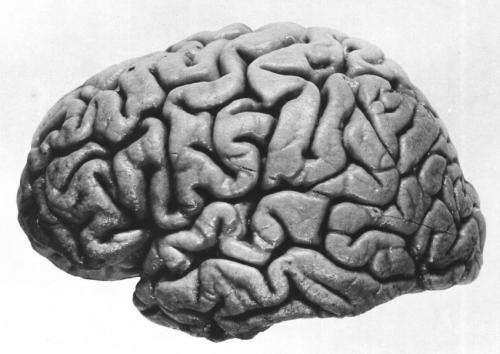September 19, 2014 report
Researchers take a look at the competitor's brain, find possible switching mechanism

(Medical Xpress)—A small team of researchers at Yale University has found a possible logic switching mechanism in the brains of rhesus monkeys. In their paper published in the journal Science, the team describes how they attached brain monitoring devices to three rhesus monkeys and then set up an arrangement where the monkeys played a token-matching game with a computerized opponent—with a juice reward based payoff. Watching as different parts of the brain were activated during play revealed which parts of the brain were used for different game playing techniques.
The researchers note that both animal and human learning and subsequent behavior are based mostly on reinforcement and punishment—we all repeat behaviors that get us what we want and avoid those that either don't or lead to negative outcomes. But what happens in the brain when one person or animal is faced with changes to conditions due to the behavior of another and makes changes to their own behavior because of it—when the infamous light-bulb of cartoons turns on? That's what the researchers set out to learn.
The team first taught the monkeys how to play a token-based game—the objective was to win tokens (one was gained whenever the monkey chose the same target as the opponent) by outmaneuvering an opponent, using safe or relatively risky strategies—winning six tokens meant getting a favorite juice reward.
By hooking up the monkeys to devices able to read their brain waves, the researchers were able to see which parts of the brain were being used during different parts of game playing, most specifically, when a monkey chose to deviate from what it had previously learned was a successful move—because of perceived deviations taken by its opponent. They found that a part of the brain known as the dorsomedial prefrontal cortex (dmPFC) became active when the monkeys chose to respond to a perceived deviation from normal play by an opponent, suggesting that the dmPFC might be a switch of sorts (when their brain has that "aha! I see what you're doing" moment) between simple behavior processing and behavior processing that takes more thought, and strategy. They noted also that there were varying degrees of activity in the dmPFC depending on how much the monkey chose to deviate from normal play, suggesting that the dmPFC might serve as an override control mechanism to switch on processes that are more capable of dealing with suddenly changing circumstances.
The researchers also note that in people, some mental illness are characterized by an inability to perform such switching, which might mean therapies dedicated to the dmPFC might be an effective treatment option.
More information: Neural correlates of strategic reasoning during competitive games, Published Online September 18 2014. Science DOI: 10.1126/science.1256254
ABSTRACT
Although human and animal behaviors are largely shaped by reinforcement and punishment, choices in social settings are also influenced by information about the knowledge and experience of other decision-makers. During competitive games, monkeys increased their payoffs by systematically deviating from a simple heuristic learning algorithm and thereby countering the predictable exploitation by their computer opponent. Neurons in the dorsomedial prefrontal cortex (dmPFC) signaled the animal's recent choice and reward history that reflected the computer's exploitative strategy. The strength of switching signals in the dmPFC also correlated with the animal's tendency to deviate from the heuristic learning algorithm. Therefore, the dmPFC might provide control signals for overriding simple heuristic learning algorithms based on the inferred strategies of the opponent.
© 2014 Medical Xpress


















